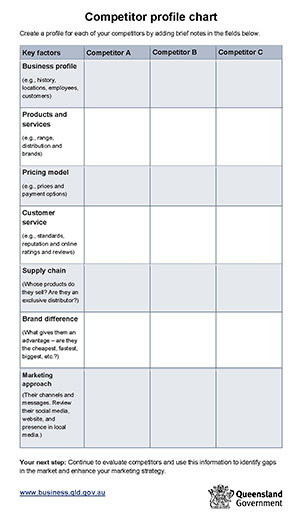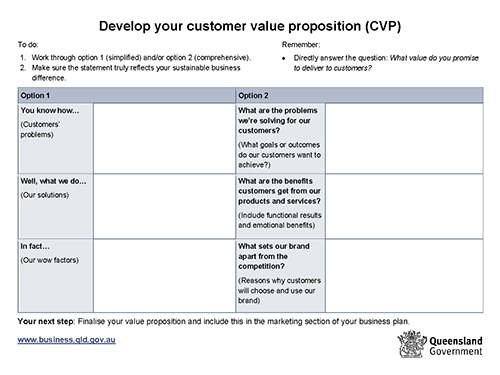Identifying your competitive advantage and value proposition
To stay ahead, you must show the unique value your business offers. Understanding your customers and your competitors can help you develop your value proposition.
Find your competitive advantage in 3 steps
Your competitive advantage is the combination of marketing elements that sets your business apart. It's about the unique benefit customers get when they do business with you. Practical examples include:
- free home delivery
- a money-back guarantee
- personalised service.
Finding your competitive advantage will help you to make the most of your existing strengths and to prioritise improvements. A strong competitive advantage will:
- highlight customer benefits
- reflect your business strengths
- be clear, simple and unique
- change over time to adapt to new conditions.
The following 3 steps can help you find your competitive advantage.
-
To uncover gaps in the market, you need to analyse and understand your customers and competitors. This will show why you're making sales (the drivers for your business) and the reasons why not (the barriers against your business).
Use the free market research kit and refer to your marketing strategy.
Action item: Know your customers
Ask yourself:
- why do customers buy from my business?
- why do customers buy from my competitors?
- why do potential customers choose not to buy at all?
Competitor profile chart
An easy way to better understand your competitors is to complete a competitor profile chart. It can show you:
- where there are gaps in the market
- how you can stand out from the competition.
You can:
- download the print-optimised version of the competitor profile chart to fill out and save for future reference
- use the online template to profile your competitors.
-
When customers buy a product or service, they actually buy the benefits they expect to get from it. They are buying the experience and the outcome.
How does your competitive advantage benefit your customers? For example:
- do your products make their life simpler, or more exciting?
- do your services make them feel better?
Remember that different benefits may appeal to different customers.
Imagine you're running an award-winning sandwich shop. You:
- source fresh, chemical-free, local ingredients
- make high-quality gourmet sandwiches to order.
Different customers will be attracted by different benefits. They may, for example:
- like to have gourmet sandwiches for lunch
- need sandwiches made to order to accommodate food allergies
- want to support local growers and farmers.
It's about the customer
Find out what trends are shaping the market and what benefits your customers want. Then find practical ways to address those needs.
Action item: Determine your difference
Use our template for reviewing your 7 Ps of marketing to help identify:
- the benefits you're offering
- what makes your business unique.
While doing this, ask yourself:
- how important are the added benefits you're offering to customers?
- how well does your business offer these benefits compared to your competition?
Focus on, and promote, benefits:
- that customers value
- in areas where your business outperforms your competitors.
Check that your marketing collateral includes the most compelling benefits.
-
One way to stand out from your competitors is to innovate. Focus on solving problems, even problems your customers are not yet aware of. You could, for example, change existing or design new:
- products
- services
- experiences
- business processes.
Action item: Look at your customers' journey
Map out the end-to-end customer journey to see where customers might:
- experience issues when doing business with you (pain points)
- be pleasantly surprised or impressed (wow factors).
This will help you plan and make business improvements.
Clarify your customer value proposition (CVP)
Your marketing programs will be more focused and effective when you:
- know what your competitive advantage is
- have a unique and relevant brand positioning.
Improve this further by being clear about your customer value proposition (CVP).
-
A good CVP is a short, powerful statement about how you deliver value to your customers.
It answers the question:
What value do you promise to deliver to customers in exchange for payment?
A business typically has 1 value proposition. It's about the big picture—your main and consistent difference.
-
Your value proposition links your:
- business plan (business model and operations)
- target segments (customer needs and expectations).
The CVP:
- is often used as a core statement in business plans and marketing strategy documents
- guides external communication and how you go to market. For example, it will enable you to promote your difference, effectively pitch to stakeholders and increase sales conversion.
-
Use these 3 points to clarify your CVP:
- You know how... (the problems)
- Well, what we do... (our solutions)
- In fact... (our wow factors)
Example CVP
Think about the sandwich shop offering a gourmet alternative to customers.
- You know how… it's hard to find a quality sandwich at a reasonable price in our local area? Lunch time can become just another chore in your day.
- Well, what we do… is ask you what you really want. We then make every sandwich to order using the best, chemical-free, locally sourced ingredients.
- In fact… we get to know you by name—and your favourite sandwich. And we like to have a chat. That's all part of our award-winning service.
-
To write a more comprehensive CVP, answer these questions:
- What are the problems we're solving for our customers?
- What outcomes do they want to achieve?
- What benefits do customers get from our products and services? This can be practical or emotional.
- What sets our brand apart from the competition in terms of value? Why should customers choose and use our brand?
Example CVP
Think about the sandwich shop and how it compares to a chain of sandwich shops.
'Lunch time should be your time. Time to relax and enjoy. Time to get away from it all. Something to look forward to. But all too often it's the opposite of these things—more stress and heavy food. That's why our sandwiches are made with love, for what you love.
Choose your ingredients and we'll make every sandwich fresh to order.
You'll be supporting the local growers and farmers and you'll be supporting us, a family-owned business in the local community. You'll enjoy the friendly chat and the gourmet food, without the gourmet price. It's the award-winning service and taste that will keep you coming back.'
-
Business is about exchanging value. Value is based on what the customers thinks about the price they paid relative to the benefits they received. What will the answer be if a customer asks: What's in it for me (WIIFM)?
Read more about pricing products and services.
Keep the following in mind when you evaluate your customer value proposition:
- existing business capability – current state
- proposed enhancements – ideal future
- the roadmap to get there – action plan.
Customer value proposition template
Develop your customer value proposition (CVP) by:
- reading the information above
- searching online for 'customer value proposition examples'
- using the template to write your CVP.
Create unique selling points (USPs)
Based on your competitive advantage, you'll have one or more unique selling points (USPs).
-
A USP:
- is a short, snappy and memorable line
- conveys what sets you apart from competitors
- is mostly used for marketing communications
- is also known as a 'unique selling proposition'.
It answers the question:
Why should customers buy from you?
-
You'll need a USP, or a series of USPs, when you run a marketing campaign. You'll also need to add it to the creative brief if you partner with an agency.
The most effective way to stand out in a crowded market is with a unique selling point and a distinctive brand.
The USP must convey the benefit you deliver, relative to competitors, that your target persona values most. This benefit may be real or perceived.
You'll likely need many versions of your USPs, depending on your:
- products and services
- target segments
- direct competitors.
-
To create and deliver high-impact marketing communications, follow these steps:
- Analyse your market research insights.
- Identify potential gaps/opportunities.
- Consider the needs of your customers.
- Draft and test your USPs.
Use the name 'unique selling point' as a guide:
- unique – highlight a meaningful difference
- selling – deliver the message in a persuasive way
- point – deliver a single-minded message.
Think about potential areas like:
- products or services not currently offered by competitors
- customer groups not currently catered for by competitors
- aspects of your business that are different from competitors.
Your USPs should be true to your business—you must be able to deliver the promise.
Example USPs
Using the local sandwich shop as an example and looking at its CVPs, we can identify the main points of difference and write USPs to match:
- Service: 'Every single sandwich made fresh with love.'
- Choice of ingredients: 'Only the finest, chemical-free ingredients.'
- Local: 'Our local farmers and growers say thanks.'
Meet your legal obligations
While competition may be fierce, it's important to still follow fair and legal practices. Every business must comply with the relevant laws while trying to find a position in the market.
The most important legislation to be aware of is the Competition and Consumer Act 2010. It provides a fair and competitive operating environment and covers:
- contract law and unfair contract terms
- consumer rights when buying goods and services
- product safety
- unsolicited consumer agreements, including door-to-door and telephone sales
- penalties, enforcement powers and the rights of consumers to seek compensation.
To understand your rights and responsibilities in the field of competition law, you can read:
- Australian Consumer Law guidance – advice on how to comply with the Competition and Consumer Act 2010
- Office of Fair Trading sales practice guidance – advice on making your sales practices are fair and legal.
Maintain your relevance
The only constant in business is change. That's why it's important to regularly review the trends that are shaping your market. These could include things like new:
- behaviours
- technologies
- competitors
- solutions.
You may need to evolve your business, but change also creates opportunities. This will require change management. Find out more about how to adapt and change your business.
The marketing field is always changing too. There's often an overemphasis on 'shiny new things.' It's good to stay up to date, but always:
- refer to the fundamentals of marketing
- adopt a strategic approach.
Your goal is to achieve your marketing objectives. To support this journey, make sure you refer to industry sources and external partners for:
- resources
- training
- advice.
Visit the Australian Marketing Institute to find information on best practice and standards.
Also consider...
- Find help to write a marketing strategy and plan.
- Learn more about branding your business.
- Find information on how to become a customer-focused business.
- Access tips and calculators to help you successfully price products and services.
- Find out more about writing a business capability statement.
- Watch our Price and profitability webinar for information and advice on how to price your products and services.

